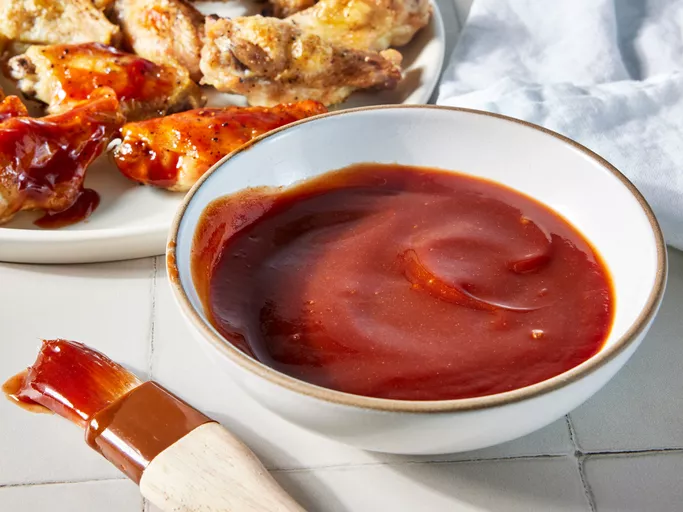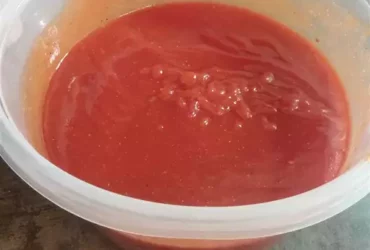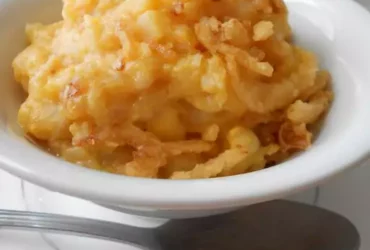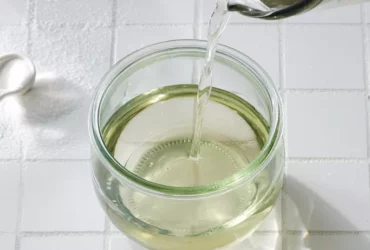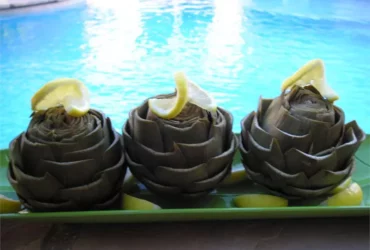Ingredients
Main Sauce Components
The foundation of a rich and flavorful bar-b-que sauce lies in its ingredients, which often include a combination of spices, sweeteners, and acidic components to create a harmonious balance of flavors.
When it comes to the main sauce components, there are several key elements that contribute to the overall character of the sauce. These can be broadly categorized into the following groups: acidic components, sweeteners, spices, and thickeners.
Acidic Components
The primary function of acidic ingredients in bar-b-que sauce is to add a tangy flavor and help to balance out the richness of the other ingredients. Common acidic components include vinegar (such as apple cider or white distilled), citrus juice, or tomatoes. These ingredients not only contribute flavor but also help to preserve the sauce by inhibiting the growth of bacteria.
Sweeteners
Sweeteners add a rich and velvety texture to the sauce while providing balance to the acidic components. Popular sweeteners include brown sugar, honey, maple syrup, or molasses. The type and amount of sweetener used can greatly impact the overall flavor profile of the sauce.
Spices
The spice blend is what sets a particular bar-b-que sauce apart from others. A combination of ground spices such as paprika, chili powder, cumin, garlic powder, onion powder, salt, and black pepper can create a deep and complex flavor profile. Each spice contributes its unique characteristics to the overall taste experience.
Thickeners
The purpose of thickeners is to achieve the desired consistency for the sauce while ensuring that it remains stable during cooking. Common thickeners include tomato paste, flour, or cornstarch, which help to prevent separation and ensure a smooth texture.
A balanced bar-b-que sauce relies on a delicate harmony between these main sauce components. Experimenting with different combinations of acidic components, sweeteners, spices, and thickeners allows for the creation of unique flavor profiles that cater to individual tastes and preferences.
The art of creating a delectable Bar-B-Que sauce begins with selecting the right ingredients. A good BBQ sauce should have a balance of sweet, tangy, and smoky flavors to complement the richness of grilled meats.
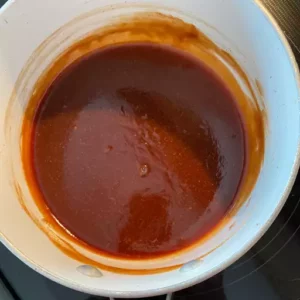
For this recipe, you will need the following ingredients
- 1 cup ketchup: This provides a thick and rich base for the sauce, helping it cling to meats as they grill. Look for a high-quality ketchup with minimal added sugars.
- 1/2 cup apple cider vinegar: This adds a tangy flavor that helps balance out the sweetness of the ketchup. Apple cider vinegar also contains antioxidants and has anti-inflammatory properties.
- 2 tablespoons brown sugar: Brown sugar adds a deep, caramel-like flavor to the sauce. It’s also a good source of minerals like potassium and magnesium.
- 1 teaspoon smoked paprika: This gives the sauce a smoky depth that’s perfect for grilled meats. Smoked paprika is made from sweet peppers that have been smoked over oak wood.
- 1/2 teaspoon ground cumin: Cumin adds a warm, earthy flavor to the sauce. It’s also known for its digestive benefits and can help reduce inflammation.
- 1/4 teaspoon cayenne pepper: This adds a touch of heat to the sauce. You can adjust the amount to your taste, or omit it altogether if you prefer a milder sauce.
- 2 cloves garlic, minced: Garlic is a classic addition to many BBQ sauces. It has antimicrobial properties and can help add depth and complexity to the flavor.
- Salt and black pepper: These are essential seasonings that bring out the flavors of all the other ingredients in the sauce. Use fresh black peppercorns for the best flavor.
Optional ingredients include
- 1/4 cup Worcestershire sauce: This adds a savory, umami flavor to the sauce. It’s made from a combination of tamarind, soy sauce, and other spices.
- 2 tablespoons honey: If you prefer a sweeter BBQ sauce, add some honey to balance out the tanginess of the vinegar.
- Remember that the key to making great BBQ sauce is to taste it as you go and adjust the seasoning accordingly. This way, you can get the perfect balance of flavors for your grilled meats.
1 cup ketchup
Ketchup is one of the primary ingredients used in many bar-b-q sauce recipes. It serves as a base that contributes to the distinctive flavor and texture of the sauce.
The amount of ketchup called for in this recipe is 1 cup, which is a relatively significant proportion of the total sauce volume. This reflects the importance of ketchup in defining the overall character of the bar-b-q sauce.
Ketchup contains a mixture of tomato puree, sugar, vinegar, spices, and other ingredients that work together to produce its distinctive flavor profile. In the context of this recipe, the 1 cup of ketchup is used to add depth and richness to the sauce.
The role of ketchup in this bar-b-q sauce recipe can be seen as both a flavor enhancer and a binding agent. The sweetness and acidity in the ketchup help balance out the other ingredients, while its thick, syrupy texture helps hold all the components together.
It’s worth noting that using 1 cup of ketchup gives this bar-b-q sauce recipe a fairly strong tomato flavor profile. If you prefer a milder taste or want to create a different flavor profile altogether, you could consider substituting some or all of the ketchup with other ingredients such as brown sugar, honey, apple cider vinegar, smoked paprika, or chili powder.
When incorporating 1 cup of ketchup into your bar-b-q sauce recipe, make sure to whisk it thoroughly before adding it to the rest of the ingredients. This will help ensure that the ketchup is evenly distributed throughout the mixture and contributes consistently to the final flavor and texture of the sauce.
1/2 cup apple cider vinegar
When it comes to creating a delicious and authentic Bar-B-Que sauce, one key ingredient stands out for its ability to add depth and balance to the flavor profile: _apple cider vinegar_.
The recommended amount of _apple cider vinegar_ in this recipe is 1/2 cup, which may seem like a significant quantity, but trust us, it’s essential for achieving that perfect blend of tangy and sweet notes.
So why is _apple cider vinegar_ such an important ingredient in Bar-B-Que sauce? For one, its acidity helps to cut through the richness of other ingredients, creating a sense of balance and harmony on the palate.
But that’s not all – _apple cider vinegar_ also plays a crucial role in bringing out the flavors of other ingredients. By adding a hint of sweetness and a touch of spice, it enhances the overall complexity of the sauce and elevates it to new heights.
In particular, the 1/2 cup amount of _apple cider vinegar_ serves as a counterpoint to the sweetness of the ketchup and brown sugar, preventing the sauce from becoming too cloying or overpowering. It’s a delicate balance that requires just the right amount of acidity to make everything come together in perfect harmony.
Of course, it’s worth noting that you can adjust the amount of _apple cider vinegar_ to taste. Some people prefer a stronger, more acidic flavor, while others like it milder and sweeter. Experiment with different ratios to find your ideal balance.
2 tablespoons brown sugar
The key to creating an authentic Bar-B-Que sauce lies in the selection and combination of its ingredients. For this recipe, we will focus on a specific quantity of one crucial component: brown sugar.
Brown sugar serves not only as a sweetener but also as a flavor enhancer in Bar-B-Que sauce. Its unique caramel-like taste adds depth and richness to the overall flavor profile of the sauce. The amount specified in this recipe is two tablespoons, which is a moderate quantity that allows for a balance between sweetness and other flavors.
The use of brown sugar in Bar-B-Que sauce dates back to the early days of American barbecue, where cooks would use molasses or brown sugar to create a sweet and tangy glaze for meats. Over time, this practice evolved into various regional styles and recipes, all incorporating some form of sugar as an essential component.
When using two tablespoons of brown sugar in Bar-B-Que sauce, it’s crucial to consider the other ingredients and their proportions. A good balance between sweet, sour, salty, and smoky flavors is necessary to create a well-rounded sauce that complements a variety of meats and cooking styles.
Key Points about Brown Sugar:
- The amount specified in this recipe, two tablespoons, is moderate and allows for balance between sweetness and other flavors.
- Brown sugar serves as a flavor enhancer, adding depth and richness to the overall flavor profile of Bar-B-Que sauce.
- The use of brown sugar dates back to early American barbecue practices, where cooks would create sweet and tangy glazes for meats.
2 tablespoons smoked paprika
The ingredients required to make a delicious Bar-B-Que Sauce are numerous, and one crucial component is the smoked paprika.
Smoked Paprika: A Key Ingredient in Bar-B-Que Sauce
Smoked paprika, also known as pimentón, is a type of spice made from ground dried bell peppers that have been smoked over oak wood fires.
This gives the paprika a deep, rich flavor that adds depth and complexity to dishes like our Bar-B-Que Sauce recipe.
What Smoked Paprika Brings to the Table
- Rich, smoky flavor: Smoked paprika adds a robust, slightly sweet, and smoky taste that complements meats perfectly.
- Aromatic properties: The smoked paprika contributes an enticing aroma that enhances the overall sensory experience of our Bar-B-Que Sauce.
- Depth and complexity: This spice helps to balance out other flavors in the sauce, creating a harmonious blend that is both bold and refined.
In our Bar-B-Que Sauce recipe, we use smoked paprika as one of the key ingredients. Specifically, we require 2 tablespoons of this aromatic spice to achieve the perfect balance of flavors.
How to Use Smoked Paprika in Our Recipe
- Add the 2 tablespoons of smoked paprika to a saucepan with other ingredients like onions, garlic, tomato paste, and vinegar.
- Simmer the mixture over medium-low heat for about 10 minutes, allowing the flavors to meld together.
- Strain the sauce through a fine-mesh sieve or cheesecloth to remove any solids and achieve a smooth consistency.
The end result is a mouthwatering Bar-B-Que Sauce that combines the rich flavors of smoked paprika with other essential ingredients, making it perfect for slathering on meats during your next barbecue or cookout!
1 teaspoon ground cumin
The key to a rich and flavorful Bar-B-Que sauce lies in the carefully selected ingredients, particularly when it comes to the _aromatic spices_ that add depth and character to the dish.
One such essential spice is ground cumin, which plays a crucial role in enhancing the overall flavor profile of the sauce. This _warm and earthy spice_ originates from the seeds of the _cuminum cyminum plant_, native to the Middle East and the Indian subcontinent.
Cumin’s unique taste, often described as slightly bitter and nutty, is a result of its high concentration of _cuminaldehyde_, a chemical compound responsible for its distinctive aroma. This compound also contributes to cumin’s medicinal properties, making it a valuable ingredient in various traditional remedies and culinary applications.
When used in the context of Bar-B-Que sauce, ground cumin serves as a perfect complement to other spices and ingredients, such as smoked paprika, brown sugar, and vinegar. Its earthy undertones balance out the sweetness and smokiness of these components, resulting in a harmonious blend of flavors that define a classic _Southern-style Bar-B-Que sauce_.
In terms of usage, it is recommended to use 1 teaspoon of ground cumin per cup of sauce, adjusting to taste as needed. This will ensure the perfect balance between spices and prevent overpowering the other ingredients with an excessive amount of _cumin flavor_.
The art of crafting a mouth-watering Bar-B-Que Sauce begins with selecting an array of aromatic and flavorful ingredients. Here’s a comprehensive guide to help you create your own signature sauce:
The foundation of any Bar-B-Que Sauce is a blend of sweet, tangy, spicy, and smoky flavors. The primary ingredients are:
- Pureed Tomato: The base of the sauce is typically made from crushed or pureed tomatoes, which provide natural sweetness and a burst of juicy flavor.
- Onion: Caramelized onions add depth and complexity, as well as a sweet, slightly savory taste. You can use either raw or cooked onions, depending on your preference.
- Ketchup: A small amount of ketchup adds a touch of sweetness and helps to balance out the tanginess of the tomato puree.
- Spices: The magic of Bar-B-Que Sauce lies in its unique blend of spices, which can include paprika, garlic powder, onion powder, cayenne pepper (for added heat), and brown sugar.
- Smoking agents: To capture that authentic smoky flavor, you may want to add a touch of liquid smoke or smoked paprika.
- Flavor enhancers: Consider adding a splash of vinegar (apple cider or balsamic work well) to balance out the flavors and enhance the overall taste experience.
- Worcestershire sauce: A small amount of this condiment adds depth, umami flavor, and a hint of sweetness.
To bring all these ingredients together and create a smooth, velvety sauce, you’ll need to combine them in the right proportions. Here’s a basic recipe you can use as a starting point:
Bar-B-Que Sauce Recipe: (Makes approximately 2 cups)
-
- Pureed Tomato: 1 cup
- Crush or puree 4-6 fresh tomatoes, depending on size.
- Onion: 1/2 cup
- Caramelize 1 medium onion in a pan until softened and fragrant.
- Ketchup: 2 tablespoons
- Add to the sauce for sweetness and balance.
- Pureed Tomato: 1 cup
-
- Spices: 1 tablespoon each of:
- Paprika
- Garlic powder
- Onion powder
- Cayenne pepper (optional)
- Brown sugar
- Smoking agents: 1/4 teaspoon each of:
- Liquid smoke
- Spices: 1 tablespoon each of:
-
- Flavor enhancers: 2 tablespoons each of:
- Vinegar (apple cider or balsamic)
- Worcestershire sauce: 1 teaspoon
- Add to the sauce for depth and umami flavor.
- Flavor enhancers: 2 tablespoons each of:
Combine all the ingredients in a large saucepan, whisking until smooth. Bring the mixture to a simmer over medium heat, then reduce the heat to low and let it cook for at least 30 minutes, stirring occasionally, until the flavors have melded together and the sauce has thickened slightly.
This Bar-B-Que Sauce recipe makes approximately 2 cups of sauce. You can store it in an airtight container in the refrigerator for up to 2 weeks or freeze it for up to 3 months. When you’re ready to use it, simply reheat the sauce over low heat and brush it generously onto your favorite Bar-B-Que delights!
Enjoy experimenting with this recipe and making adjustments to suit your personal taste preferences! The world of Bar-B-Que Sauce is all about experimentation and creativity, so don’t be afraid to try new ingredients or flavor combinations.
Instructions
Sauce Preparation
The process of preparing barbecue sauce from scratch requires attention to detail and adherence to specific instructions. To create a rich and flavorful sauce, one must first gather the necessary ingredients, which typically include ketchup, vinegar, brown sugar, smoked paprika, garlic powder, onion powder, salt, black pepper, cayenne pepper, and water.
The first step in preparing barbecue sauce involves combining the ketchup, vinegar, brown sugar, smoked paprika, garlic powder, onion powder, salt, black pepper, and cayenne pepper in a medium-sized saucepan. The ingredients should be whisked together until they are well combined and there are no visible lumps.
Next, one must add the water to the saucepan and whisk the mixture until it is smooth and consistent. It’s essential to use the correct ratio of ingredients to achieve the desired consistency and flavor profile for your barbecue sauce.
The mixture should then be placed over medium heat on a stovetop or in a saucepan set over low heat, depending on the manufacturer’s instructions. As the mixture heats up, it will start to simmer and reduce slightly, resulting in a thicker, more robust consistency.
To enhance the flavor of your barbecue sauce, one may choose to add additional ingredients such as Worcestershire sauce, hot sauce, or other spices. This step allows for customization and tailoring the sauce to suit individual preferences.
Once the sauce has reached the desired thickness and flavor profile, it can be removed from heat and allowed to cool completely before transferring it to a clean glass jar or bottle with an airtight lid. The barbecue sauce is now ready for use in various cooking applications, including brushing it onto meats during the last stages of grilling or roasting.
When using your homemade barbecue sauce, it’s essential to note that the flavor profile will continue to develop and mature over time as the ingredients combine and meld together. This allows the flavors to intensify and become even more complex, resulting in a deeper, richer taste experience.
In summary, preparing barbecue sauce from scratch involves combining specific ingredients in a particular ratio, heating them up to achieve the desired consistency, and allowing the flavors to mature over time. By following these steps, one can create a rich, flavorful, and versatile barbecue sauce that complements various cooking applications.
Instructions for preparing Bar-B-Que Sauce are a crucial part of any BBQ enthusiast’s arsenal, and understanding their importance can elevate one’s cooking skills to new heights.
A good set of instructions should provide clear guidance on the preparation of each ingredient and step in the recipe. This is especially important when working with ingredients that require precise measurement or temperature control, such as vinegar, sugar, and spices.
For example, when making a BBQ sauce, it’s essential to mix the dry ingredients like paprika and cayenne pepper together separately from the wet ingredients like ketchup and brown sugar. This ensures that each component is evenly distributed throughout the final product.
The order in which you add ingredients can also impact the overall flavor profile of your BBQ sauce. Generally, it’s a good idea to add the dry spices first, followed by the wet ingredients like tomato paste and vinegar. This allows each component to meld together and create a rich, complex flavor.
An excellent set of instructions will also provide guidance on how to handle common issues that may arise during preparation. For instance, if your BBQ sauce is too thick or too thin, what adjustments can you make to achieve the desired consistency?
Furthermore, having clear and concise instructions allows home cooks and professional chefs alike to focus on the creative aspect of cooking rather than getting bogged down in the nitty-gritty details. By following a well-crafted set of instructions, one can create a delicious BBQ sauce that’s tailored to their individual taste preferences.
In conclusion, when it comes to preparing Bar-B-Que Sauce, having clear and detailed instructions is crucial for achieving success in the kitchen. Whether you’re a seasoned pro or just starting out, taking the time to follow a well-written recipe can make all the difference between an average dish and a truly exceptional one.
In a medium saucepan, combine ketchup, apple cider vinegar, brown sugar, smoked paprika, and cumin.
When it comes to following instructions, clarity and precision are crucial. In a recipe like this one for Bar-B-Que sauce, precise measurements and straightforward language can make all the difference in achieving a delicious and consistent result.
The first instruction, “In a medium saucepan,” tells us exactly what we need to do – use a saucepan that’s of medium size. This is important because it affects not only the cooking time but also the overall texture of the sauce. If we’re using a pan that’s too large or too small, it can impact the way the flavors combine and the final consistency.
The next line, “Combine ketchup, apple cider vinegar, brown sugar, smoked paprika, and cumin,” outlines the ingredients and tells us what to do with them – mix them together in the saucepan. Here, it’s essential to follow the order of operations: adding the liquid ingredients first (ketchup and apple cider vinegar), then the sweet ingredient (brown sugar), and finally the spices (smoked paprika and cumin). This helps prevent lumps from forming and ensures that the flavors have a chance to meld together.
The instruction also highlights the importance of using specific types of ingredients. For example, it specifies “ketchup” rather than just “tomato sauce.” This is because ketchup has a distinct flavor profile and texture that’s perfect for Bar-B-Que sauce. Similarly, “apple cider vinegar” gives the sauce a tangy, slightly sweet taste that complements the smokiness of the paprika.
Furthermore, using the correct proportions of ingredients can make all the difference in achieving the right balance of flavors. In this recipe, the combination of ketchup, apple cider vinegar, and brown sugar provides a rich, slightly sweet base that’s then enhanced by the smoky flavor of the paprika and cumin. This is where precision and attention to detail come into play – we need to measure out the ingredients carefully and mix them together in the right order.
Overall, following instructions like these is not just about following a set of steps; it’s about understanding the underlying chemistry and physics that make a recipe work. By paying close attention to details like ingredient proportions, cooking time, and temperature, we can create dishes that are consistently delicious and authentic.
Whisk until smooth.
To whisk until smooth in the context of making a delicious bar-b-que sauce, it’s essential to understand what whisking entails and how to do it effectively.
Whisking is the process of mixing ingredients together by beating them with a tool called a whisk or a fork. In the case of making bar-b-que sauce, whisking helps to blend the ingredients together until they form a smooth and even consistency.
To whisk until smooth, follow these steps:
- Select the right tool: Choose a good-quality whisk that is sturdy enough to handle thick mixtures. A balloon whisk or a flat whisk with stiff wires works best for mixing thick sauces.
- Mix wet and dry ingredients separately: Before whisking, make sure you have separated your wet and dry ingredients. In the case of bar-b-que sauce, this means separating the ketchup, vinegar, brown sugar, Worcestershire sauce, garlic powder, onion powder, salt, black pepper, and paprika.
- Add liquid to dry ingredients: Gradually add the liquid ingredients (ketchup, water, and vinegar) to the dry ingredients. Whisk until the mixture starts to come together.
- Incorporate thickening agents (optional): If your sauce recipe includes thickening agents like cornstarch or flour, mix them with a small amount of water before adding it to the sauce. This helps prevent lumps from forming.
- Beat until smooth: Continue whisking the mixture until it reaches a smooth consistency. You can use an electric mixer if you prefer, but be careful not to overm
To check if your sauce has reached the desired smoothness:
- Check for lumps: Run your whisk through the sauce; if it still contains visible lumps, continue whisking until they’re gone.
- Test the consistency: Dip a spoon into the sauce and lift it out. If it holds its shape but is smooth and even, you’ve achieved the right consistency.
By following these steps, you’ll be able to create a delicious bar-b-que sauce that’s perfect for slathering on ribs, chicken, or pork chops!
Bring mixture to a boil over mediumhigh heat.
- To bring the mixture to a boil over medium-high heat, follow these steps:
- First, ensure that your stovetop is at a comfortable temperature for cooking.
- Next, place a large pot on the stovetop and add the mixture of ingredients from the Bar-B-Que Sauce Recipe.
- Ensure the pot has enough capacity to hold all the ingredients without overflowing.
- Select medium-high heat on your stovetop. This is usually between 7-8 on a scale of 1-10, with 1 being low and 10 being high.
- Allow the mixture to come to a boil by monitoring its temperature closely.
- The moment you notice bubbles rising from the surface and forming a gentle simmer, it’s essential not to overheat the mixture.
- To achieve this balance, use a gentle stirring motion with a spatula or spoon, keeping the heat steady at medium-high for optimal results.
- Once boiling commences, keep monitoring closely, reducing heat as needed, to avoid boiling over.
- After reaching a boil and adjusting as necessary, you can proceed with allowing the mixture to simmer at low heat while continuing the preparation of the Bar-B-Que Sauce Recipe.
Reduce heat to low and simmer for 57 minutes or until thickened slightly.
To prepare a delicious homemade bar-b-q sauce, it’s essential to follow the instructions carefully. Here are the steps involved in reducing the heat and simmering the sauce
Reducing Heat to Low
The first step is to reduce the heat of the stove or cooking surface to low. This is a critical step as it allows the sauce to cook slowly and evenly, preventing it from burning or scorching.
- Makes sure the stove or cooking surface is set to low heat
- Monitor the heat setting to ensure it remains at low level throughout the simmering process
Simmering for 57 Minutes or Until Thickened Slightly
Once the heat has been reduced, let the bar-b-q sauce simmer for at least 57 minutes. This will allow the flavors to meld together and the sauce to thicken slightly.
- Let the sauce simmer for exactly 57 minutes, or until it reaches your desired level of thickness
- Use a spoon to occasionally stir the sauce and prevent it from sticking to the bottom of the pan
- Monitor the sauce’s consistency by dipping a spoon into it. If it has thickened slightly, you can remove it from heat. If not, continue simmering for another 10-15 minutes and check again.
Remember, patience is key when cooking bar-b-q sauce. Taking your time to reduce the heat and simmer the sauce will reward you with a rich, flavorful condiment that’s perfect for slathering on meats, vegetables, or using as a dip.
Instructions are clear and concise directions or steps that guide an individual to accomplish a specific task or achieve a particular goal. In the context of the Bar-B-Que Sauce Recipe, instructions serve as a roadmap for preparing the sauce, allowing users to replicate the exact same recipe with ease.
The importance of instructions lies in their ability to simplify complex tasks by breaking them down into manageable steps. Clear instructions provide clarity and confidence, enabling individuals to understand what is required of them, thereby reducing errors and increasing productivity.
Effective instructions typically adhere to specific guidelines, including being concise, clear, and unambiguous. They should be free from jargon and technical terms that may confuse users, especially those who are new to the recipe or cooking in general.
Instructions often follow a standard format, beginning with an overview of the task, followed by step-by-step directions, and concluding with troubleshooting tips or additional information that may be useful. This structured approach ensures that users can easily navigate the instructions and complete the task at hand.
In the case of the Bar-B-Que Sauce Recipe, instructions might begin with a list of necessary ingredients, followed by steps for preparation, cooking, and assembly. They might also include tips on storage, serving, and reheating to ensure that users can enjoy their delicious homemade sauce to the fullest.
The key to crafting high-quality instructions is attention to detail and consideration for the user’s needs. Instructions should be written with empathy, taking into account potential challenges or uncertainties that users may face. By anticipating these issues, instructors can create clear, concise directions that address every aspect of the task at hand.
Ultimately, instructions play a vital role in facilitating success by equipping individuals with the knowledge and skills required to complete tasks efficiently and effectively. By following clear, well-structured instructions, users can achieve their goals with greater ease, precision, and confidence, making them an essential component of any recipe or project.
Usage and Tips
Tips for Achieving the Perfect Sauce
To achieve the perfect sauce for bar-b-que, it’s essential to understand its fundamental components and how they interact with one another.
The basic structure of a standard bar-b-que sauce typically consists of a combination of liquid ingredients such as vinegar, ketchup, brown sugar, salt, black pepper, garlic powder, onion powder, smoked paprika, Worcestershire sauce, hot sauce (optional), and spices.
For beginners, it’s recommended to start with a store-bought bar-b-que sauce and gradually experiment with adjusting the seasoning to create a taste that suits their preferences.
Tips for Achieving the Perfect Sauce:
- Add depth of flavor: Use ingredients like smoked paprika, Worcestershire sauce, and brown sugar to add complexity to your bar-b-que sauce.
- Experiment with sweeteners: Try using honey or molasses in addition to brown sugar for a more balanced sweetness level.
- Acidity balance: Add vinegar gradually, starting with a small amount and taste as you go to avoid overpowering the sauce.
- Spice it up: Add or remove spices according to your personal taste preferences, considering factors like smokiness (paprika), heat (hot sauce), and herbal undertones (oregano).
- Simmer, don’t boil: To prevent the sauce from breaking down and losing its consistency, simmer it at a low temperature (around 200-250°F) for an extended period.
- Use high-quality ingredients: Opt for pure ketchup or tomato puree, real brown sugar, and other unprocessed components to achieve the best flavor possible.
- Taste as you go: This is crucial in ensuring your sauce reaches the perfect balance of flavors. Take notes on what you add and how it affects the taste.
Remember that the key to a successful bar-b-que sauce lies in understanding its components and how they interact with each other, as well as being willing to experiment and adjust the seasoning to your liking.
The art of creating a delicious homemade Bar-B-Que sauce recipe requires a combination of flavor, texture, and technique. Whether you’re a seasoned pitmaster or just starting out on your BBQ journey, this guide will walk you through the usage and tips to create the perfect sauce for your grilled meats.
Choosing the Right Ingredients
The foundation of any good Bar-B-Que sauce lies in its ingredients. The following are essential components that will elevate your sauce game:
- Pureed Tomatoes: Fresh or canned, pureed tomatoes add a rich and tangy flavor to the sauce.
- Yellow Mustard: Adds a spicy kick and helps balance out the sweetness of the other ingredients.
- Brown Sugar: Contributes a deep and caramel-like flavor to the sauce.
- Spices and Seasonings: Cumin, smoked paprika, garlic powder, onion powder, salt, and black pepper are essential for adding depth and warmth to the sauce.
Techniques for Achieving the Perfect Consistency
A great Bar-B-Que sauce should have a smooth and velvety texture. Here’s how to achieve it:
- Blend: Use an immersion blender or transfer the sauce mixture to a blender for an ultra-smooth finish.
- Simmer and Reduce: Let the sauce simmer over low heat for about 10-15 minutes, stirring occasionally, until it has thickened slightly. This will help intensify the flavors and create a more syrupy consistency.
Shelf Life and Storage Tips
To maintain the flavor and texture of your Bar-B-Que sauce recipe, follow these storage tips:
-
- Airtight Container: Store the sauce in an airtight container to prevent contamination and exposure to air.
-
- Refrigerate: Keep the sauce refrigerated at a temperature below 40°F (4°C) to slow down bacterial growth.
-
- Freeze: Freeze the sauce for up to 3 months. Simply transfer it to an ice cube tray or an airtight container and store in the freezer.
Tips for Using Your Bar-B-Que Sauce Recipe
Incorporating your homemade Bar-B-Que sauce recipe into your BBQ routine is easy once you master its usage. Here are some valuable tips to get you started:
Cooking Techniques and Timing
To achieve the best results, consider the following cooking techniques and timing:
- Grilling: Brush your meat with the sauce during the last few minutes of grilling to prevent it from burning. You can also let it rest for a few minutes after grilling before serving.
- Slow Cooking: Apply the sauce towards the end of the cooking time, usually the last hour or so, to allow the flavors to meld together.
Meat Pairing Suggestions
Your Bar-B-Que sauce recipe pairs well with a variety of meats. Here are some classic combinations:
- Pork Ribs: A match made in heaven, as the sweetness and tanginess complement each other perfectly.
- Chicken Thighs: The smoky flavor and spices complement the richness of the chicken beautifully.
Experimenting with Variations
The beauty of a homemade Bar-B-Que sauce recipe lies in its versatility. Feel free to experiment with different ingredients and flavor combinations:
- Add Some Heat: Increase the spiciness level by adding more hot sauce or red pepper flakes.
- Get Sweet: Balance out the heat with a bit more brown sugar or honey.
Sharing Your Creation
The joy of sharing your homemade Bar-B-Que sauce recipe with friends and family is unmatched. Here are some tips for sharing your creation:
Hosting BBQ Parties
Whether you’re hosting a small gathering or a large BBQ party, your delicious Bar-B-Que sauce recipe will be the star of the show:
- Create a Sauce Station: Set up a sauce bar with your homemade Bar-B-Que sauce and offer guests a variety of toppings.
- Get Creative with Garnishes: Add some fresh herbs, edible flowers, or microgreens to give your dish an extra pop of color and flavor.
Sharing Your Secret Sauce Recipe
When sharing your secret Bar-B-Que sauce recipe, consider the following:
- Create a Sense of Community: Share the recipe with friends, family, and online communities to build a sense of camaraderie.
- Be Mindful of IP Protection: Be cautious when sharing your recipe online or in public forums to protect your intellectual property.
Making it Your Own Tradition
Your homemade Bar-B-Que sauce recipe can become a beloved family tradition. Here’s how:
Creating Family Traditions
Pass down the recipe and cooking techniques to future generations by incorporating it into family traditions:
- Create a Family Recipe Book: Collect recipes, stories, and photos to create a keepsake book that will be treasured for years to come.
- Host Annual BBQs: Gather the family together annually to celebrate special occasions with your signature Bar-B-Que sauce dish.
Sharing Your Heritage
Your Bar-B-Que sauce recipe may have roots in a specific cultural or regional heritage. Share that heritage by:
-
- Incorporating Traditional Ingredients: Use ingredients and spices that reflect your family’s cultural heritage to add depth and authenticity to the dish.
-
- Telling Stories Behind the Recipe: Share the stories behind the recipe, including its origins and history, to create a sense of connection with others.
Embracing Your Creativity
Your homemade Bar-B-Que sauce recipe is a reflection of your creativity. Don’t be afraid to experiment and try new things:
- Get Inspired by Other Recipes: Draw inspiration from other recipes, cooking techniques, and cuisines to create something entirely new.
- Experiment with New Ingredients: Try new ingredients, spices, and flavor combinations to add a twist to your Bar-B-Que sauce recipe.
For a sweeter sauce, add more brown sugar; for a tangier sauce, add more apple cider vinegar.
The key to creating a balanced and flavorful BBQ sauce lies in understanding how different ingredients interact with one another. When it comes to achieving a sweeter or tangier taste, the right balance of sugar and acidity can make all the difference.
To create a sweeter sauce, you can add more brown sugar. This will not only enhance the sweetness but also help to balance out any bitterness from other ingredients like onions or garlic. Start by adding a small amount of brown sugar and taste as you go, adjusting the amount to your liking.
On the other hand, if you prefer a tangier sauce, you can add more apple cider vinegar. This will not only add a burst of acidity but also help to cut through richness from ingredients like tomato puree or molasses. Like with brown sugar, start by adding a small amount and taste as you go, adjusting the amount to your liking.
It’s worth noting that when working with acidic ingredients like apple cider vinegar, it’s essential to balance them out with something sweet to avoid creating an overpowering flavor profile. The ratio of sweetness to acidity is crucial in creating a well-balanced BBQ sauce.
Another tip for achieving a sweeter or tangier sauce is to use different types of sugar and acids. For example, you can try using muscovado sugar instead of brown sugar for a deeper, more caramel-like flavor. Or, you can experiment with different types of vinegar like balsamic or white wine vinegar for a distinct flavor profile.
Finally, don’t be afraid to get creative and experiment with different combinations of ingredients to create your unique BBQ sauce recipe. Remember, the key is to find that perfect balance between sweet and tangy flavors that complements the type of meat you’re cooking.
Experiment with different types of vinegar or spices to create unique flavor profiles.
The key to a great Bar-B-Que sauce lies not just in its ingredients, but also in the flavor profile it achieves.
Experimenting with different types of vinegar or spices can help you create unique and delicious variations on traditional Bar-B-Que sauce.
Start by trying out various types of vinegar, such as apple cider vinegar, balsamic vinegar, or white wine vinegar.
You can use each type to add a distinct flavor to your Bar-B-Que sauce, from the sweetness of apples to the tanginess of balsamic.
Additionally, you can also experiment with different spices and herbs, such as smoked paprika, garlic powder, or dried oregano, to create a rich and complex flavor profile.
A good rule of thumb is to start with small amounts of each new ingredient and taste as you go, adjusting the seasoning until you achieve the perfect balance.
This approach will allow you to develop your own signature Bar-B-Que sauce recipe that reflects your unique taste preferences and cooking style.
Don’t be afraid to get creative and try new combinations of ingredients – after all, that’s what makes a great Bar-B-Que sauce truly exceptional!
Store leftover sauce in an airtight container in the refrigerator for up to 2 weeks.
Storing leftover sauce is a crucial step in maintaining its quality and preventing spoilage. Here are some tips on how to store leftover BBQ sauce and keep it fresh for up to 2 weeks:
How to Store Leftover BBQ Sauce:
- Transfer the cooled sauce to an airtight container, making sure to leave about half an inch of space at the top.
- Choose a container that is specifically designed for storing liquids and has a tight-fitting lid.
- Label the container with the date it was stored and what it contains, so you can easily identify it in your refrigerator.
Storage Tips:
- Store the container in the refrigerator at a consistent temperature below 40°F (4°C).
- Keep the sauce away from direct sunlight and heat sources, as this can cause spoilage and affect the flavor.
Tips for Reheating Leftover BBQ Sauce:
- Refrigerate the sauce before reheating it to ensure food safety.
- When reheating, do so gently over low heat, as high temperatures can cause the sauce to break down and lose its texture.
By following these tips, you can enjoy your delicious homemade BBQ sauce for up to 2 weeks and prevent foodborne illness.
To get the most out of your homemade Bar-B-Que sauce recipe, it’s essential to understand its usage and tips.
Choosing the Right Cut of Meat: The key to a delicious Bar-B-Que is to choose the right cut of meat. Opt for meats that are tender and have a good marbling score, such as brisket, ribs, or pork shoulder.
Preparation: Before applying the Bar-B-Que sauce, make sure your meat is properly prepared. This includes seasoning with salt, pepper, and any other desired spices or herbs.
Basic Usage of Bar-B-Que Sauce
Cooking Times and Temperatures:
- Grilling: Preheat your grill to medium-high heat (around 375°F). Cook for 5-7 minutes per side, or until the meat is cooked through.
- Slow Cooking: Place your meat in a slow cooker and cook on low for 6-8 hours. Brush with Bar-B-Que sauce during the last 30 minutes of cooking.
Tips for the Perfect Bar-B-Que Sauce
Simmering the Sauce:
- Simmer your Bar-B-Que sauce on low heat (around 150°F) for at least an hour to allow the flavors to meld together.
Common Mistakes and Solutions
Overcooking:
Avoid overcooking your Bar-B-Que. This can result in a tough, dry texture.
Serving Suggestions
Suggested Sides:
- Coleslaw
- Baked beans
- Grilled vegetables
Remember to always taste and adjust the seasoning of your Bar-B-Que sauce as needed. Enjoy experimenting with different flavor combinations to find the perfect sauce for your favorite meats!
- Best LeadsGorilla Alternatives for 2025 - April 22, 2025
- Best Leadzai Alternatives for 2025 - April 22, 2025
- Best LeadSwift Alternatives for 2025 - April 21, 2025

